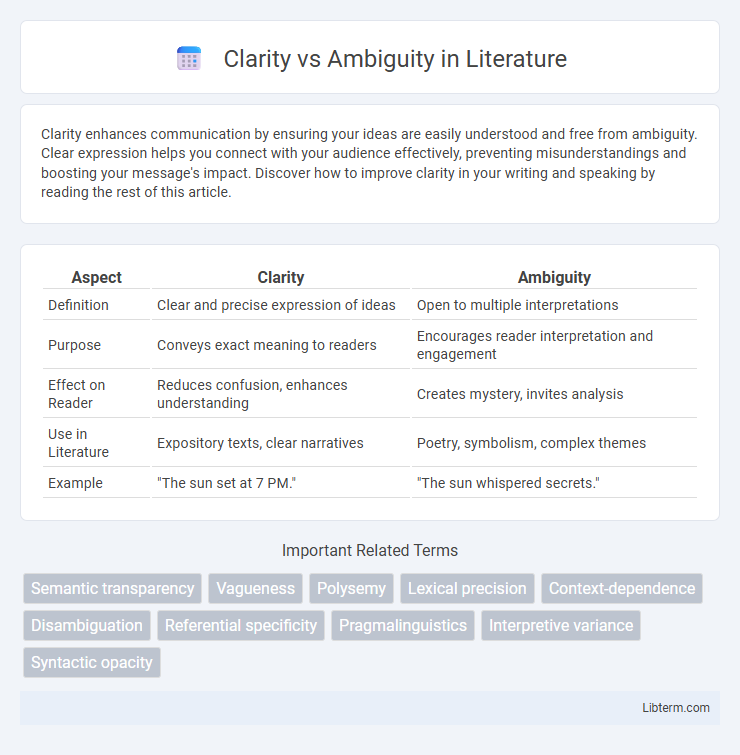Clarity enhances communication by ensuring your ideas are easily understood and free from ambiguity. Clear expression helps you connect with your audience effectively, preventing misunderstandings and boosting your message's impact. Discover how to improve clarity in your writing and speaking by reading the rest of this article.
Table of Comparison
| Aspect | Clarity | Ambiguity |
|---|---|---|
| Definition | Clear and precise expression of ideas | Open to multiple interpretations |
| Purpose | Conveys exact meaning to readers | Encourages reader interpretation and engagement |
| Effect on Reader | Reduces confusion, enhances understanding | Creates mystery, invites analysis |
| Use in Literature | Expository texts, clear narratives | Poetry, symbolism, complex themes |
| Example | "The sun set at 7 PM." | "The sun whispered secrets." |
Defining Clarity and Ambiguity
Clarity refers to the quality of being easily understood, marked by precision and unambiguous language that conveys information effectively. Ambiguity arises when language or information is open to multiple interpretations, causing confusion or uncertainty. Ensuring clarity involves using specific terms and context, while ambiguity often results from vague wording or incomplete data.
The Importance of Clear Communication
Clear communication enhances understanding by eliminating ambiguity, reducing errors, and improving collaboration across teams and stakeholders. It ensures that messages are accurately conveyed, minimizing misinterpretations that can lead to costly mistakes or conflicts. Prioritizing clarity fosters transparency, builds trust, and drives efficient decision-making in business and personal interactions.
How Ambiguity Impacts Understanding
Ambiguity in communication creates multiple possible interpretations that can lead to confusion and misinterpretation of the intended message. This lack of clarity disrupts effective information transfer, causing misunderstandings and errors in decision-making processes. Clear and precise language minimizes ambiguity, enhancing comprehension and ensuring accurate alignment of perspectives.
Benefits of Clarity in Everyday Life
Clarity enhances decision-making by providing precise information, reducing misunderstandings and errors in communication. Clear communication fosters stronger relationships and increases productivity by ensuring everyone shares the same expectations and goals. Emphasizing clarity in daily interactions minimizes stress and promotes efficient problem-solving.
Risks and Challenges of Ambiguity
Ambiguity in communication introduces significant risks such as misunderstandings, misinterpretations, and reduced efficiency, which can lead to costly errors and project delays. The challenge lies in its potential to create confusion among team members, stakeholders, or customers, undermining trust and decision-making processes. Addressing ambiguity requires clear language, precise definitions, and consistent context to minimize miscommunication and enhance organizational effectiveness.
Clarity in Professional Settings
Clarity in professional settings enhances communication by reducing misunderstandings and increasing efficiency. Precise language, clear objectives, and well-defined roles enable teams to align efforts and achieve goals effectively. Transparent communication fosters trust, supports decision-making, and drives productivity within organizations.
Ambiguity in Creative Processes
Ambiguity in creative processes fosters innovative thinking by allowing multiple interpretations and encouraging divergent ideas to emerge. This openness to uncertainty promotes flexibility and exploration, essential for breakthroughs in art, design, and problem-solving. Embracing ambiguity helps creators move beyond conventional boundaries, enabling unique and unexpected solutions to develop.
Strategies to Enhance Clarity
Employing precise language and concrete examples significantly enhances clarity in communication. Utilizing structured outlines and visual aids like charts organizes complex information for easier comprehension. Regular feedback loops ensure messages are understood as intended, reducing potential ambiguity.
When Ambiguity Can Be Advantageous
Ambiguity can be advantageous in creative writing and marketing by allowing multiple interpretations that engage diverse audiences and inspire curiosity. In negotiation or diplomacy, deliberate ambiguity provides flexibility, enabling parties to reach agreements without committing to rigid terms that might hinder collaboration. Employing ambiguity strategically fosters innovation and adaptability by leaving room for interpretation and evolving meanings.
Striking the Balance: Clarity vs Ambiguity
Striking the balance between clarity and ambiguity is crucial for effective communication and creative expression. Clarity ensures that the intended message is understood precisely, reducing misunderstandings in technical writing and legal documents. Controlled ambiguity, on the other hand, fosters creativity and multiple interpretations in literature, marketing, and art, enriching the audience's engagement and personal connection.
Clarity Infographic

 libterm.com
libterm.com